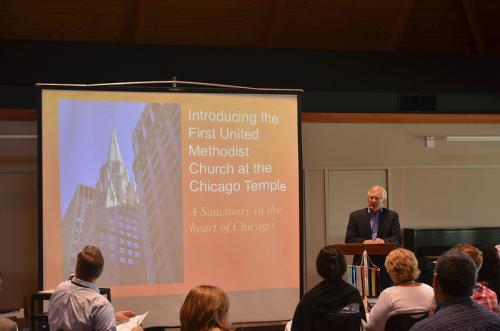
“Sun, Moon, and a Star”- Navigating and Gravitating Toward Church Through the Arts
by Michelle Lewis, MDiv. ‘13 and Dorothy Bass
First United Methodist Church at the Chicago Temple is located in the heart of Chicago’s “Loop.” About 60,000 people pass by its “crowded ways of life” each day, heading to city, county, and state government buildings, world class theatres and restaurants, businesses and banks, downtown university campuses, or the new residential buildings springing up in the area. The church building occupies part of a bank building and does not stand out as a place of worship at first glance—until one looks up twenty-three stories to see the steeple. The sanctuary remains open all day, and the congregation is strong, but even so, leaders wonder how to get passersby to pause, to notice, to reflect, to connect.
This congregation’s project, “Sun, Moon, and a Star: Navigating and Gravitating Toward Church through the Arts,” transformed a small, busy plaza next to the church building into a space for music and hospitality. At the center of this plaza is the famous sculpture by Juan Miro. In collaboration with the Art Institute and Adler Planetarium, among others, Chicago Temple secured permits for outdoor performances to be held on summer evenings, when many pass the church on their way to special events in Chicago’s lakefront parks.
The team that attended the Congregational Project Summer Seminar—Senior Pastor Phil Blackwell. organist Barry Wegner, and director of music and arts Erik Nussbaum—came with questions about how to make the most of this opportunity. “How might a weekly summer outdoor event inspire in this unique setting? How might this setting redefine urban sacred music and transform the ways people view the Christian church in the city?
How can we show our city the amazing variety of worship and ministry that occurs daily in our church?” Seminar participants encouraged them to consider also the contributions the members of their music-loving congregation could make to this series. Members later proved to be very supportive and helpful, greatly enhancing the hospitality offered in the plaza.
Erik Nussbaum wrote in the Chicago Temple News: “The Temple’s first-ever summer concert series concluded with stars of the American Chamber Opera Company presenting scenes and solos from Mozart’s ‘The Magic Flute.’ For six Wednesdays in a row, guest musical ensembles serenaded passersby as they walked east on Washington Street loaded with lawn chairs and picnic feasts, or headed west more quickly to catch their train home. Many people stopped to listen, or talk, or ask questions, share in a refreshing cup of homemade lemonade prepared by Barry Wenger, our organist, and his partner, Steve Hoover, sit on the memorial bench, or even, on one occasion, paint. All of the musicians who performed shared one element of their association with our church in common, and that is, they all have had fulfilling experiences making music here before—just not outside! All of them truly appreciate and love our church, as well, and were grateful and eager for the opportunity to share their music in such a unique setting.”
“Sun, Moon, and a Star” is remembered as a great success, though leaders acknowledge that success is hard to measure in a case such as this. “How can you quantify the nature of so many lovely, thoughtful conversations shared?” Nussbaum wondered a few weeks later. “Might we have, by drawing awareness to Miro’s statue, opened people’s thoughts about the celestial bodies, or even simply caused them to pause and have a moment of peaceful reflection amidst the usual rush hour stampede? How do you measure the gratification of hearing the unexpected…beautiful music in a strikingly pleasant setting, even if it was only as a person walked by? How many new people did members of our congregation meet?”
Although outcomes cannot be measured, those involved found it a joy to listen to beautiful music “amidst the symphony of life that is our public square, and the home of our church.”